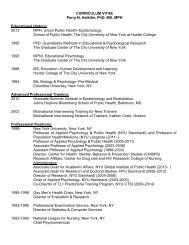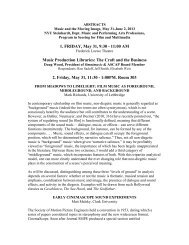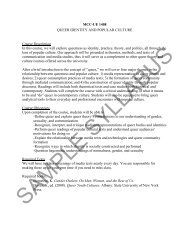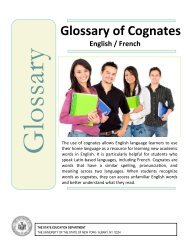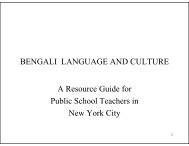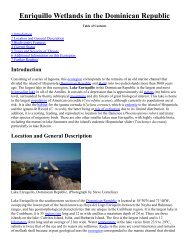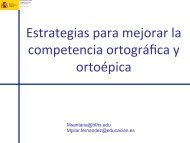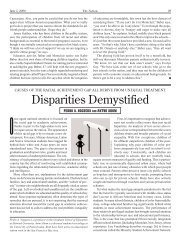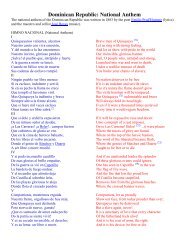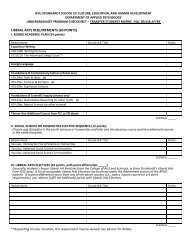Teaching and Learning Strategies for Differentiated Instruction in
Teaching and Learning Strategies for Differentiated Instruction in
Teaching and Learning Strategies for Differentiated Instruction in
You also want an ePaper? Increase the reach of your titles
YUMPU automatically turns print PDFs into web optimized ePapers that Google loves.
1<br />
<strong>Teach<strong>in</strong>g</strong> <strong>and</strong> <strong>Learn<strong>in</strong>g</strong> <strong>Strategies</strong> <strong>for</strong><br />
<strong>Differentiated</strong> <strong>Instruction</strong> <strong>in</strong> the<br />
Language Classroom<br />
2010 Ch<strong>in</strong>ese Language<br />
Teachers Summer Institute<br />
New York State ALBETAC<br />
Pace University<br />
August 27, 2010
3<br />
Reach <strong>and</strong> Teach All Children<br />
When a teacher tries to teach someth<strong>in</strong>g to the<br />
entire class at the same time, “chances are, onethird<br />
of the kids already know it; one-third will get<br />
it; <strong>and</strong> the rema<strong>in</strong><strong>in</strong>g third won‟t. So two-thirds<br />
of the children are wast<strong>in</strong>g their time.”<br />
Lillian Katz<br />
How are we bridg<strong>in</strong>g the gap?
4<br />
Reach <strong>and</strong> Teach All Children<br />
If children do not learn the<br />
way we teach them, then we<br />
must teach them the way<br />
they learn.
5<br />
By the end of this session…<br />
Participants will have a clear underst<strong>and</strong><strong>in</strong>g of what<br />
differentiation is <strong>and</strong> is not.<br />
Participants will work on assess<strong>in</strong>g their learn<strong>in</strong>g<br />
styles <strong>and</strong> will receive sample assessments that can<br />
be used as models <strong>for</strong> the rest of the school year.<br />
Based on assessment results, participants will make<br />
practical applications of their f<strong>in</strong>d<strong>in</strong>gs. They will<br />
differentiate <strong>in</strong>struction by group<strong>in</strong>g students more<br />
effectively.<br />
Participants will work on differentiated activities that<br />
can be used as models <strong>for</strong> the rest of the school<br />
year.
6<br />
Differentiat<strong>in</strong>g <strong>Instruction</strong> …<br />
Chances Are, You‟re Already Do<strong>in</strong>g It !
Activity 1--Take a few m<strong>in</strong>utes to create a Circle Map.
What I know<br />
What I underst<strong>and</strong><br />
Differentiat<strong>in</strong>g<br />
<strong>Instruction</strong><br />
What I do<br />
How do I know<br />
8
9<br />
<strong>Differentiated</strong> <strong>Instruction</strong> is Based<br />
on the Follow<strong>in</strong>g Beliefs<br />
Students differ <strong>in</strong> their learn<strong>in</strong>g profiles.<br />
Classrooms <strong>in</strong> which students are active learners,<br />
decision makers <strong>and</strong> problem solvers are more<br />
natural <strong>and</strong> effective.<br />
Effective classrooms are ones <strong>in</strong> which students are<br />
not served with a “one-size-fits-all” curriculum but<br />
are active recipients of <strong>in</strong><strong>for</strong>mation.<br />
“Cover<strong>in</strong>g <strong>in</strong><strong>for</strong>mation” takes a backseat to mak<strong>in</strong>g<br />
mean<strong>in</strong>g out of important ideas.<br />
Toml<strong>in</strong>son, Carol Ann. How to Differentiate <strong>Instruction</strong> <strong>in</strong> Mixed-Ability Classrooms.
Differentiation is mak<strong>in</strong>g sure the<br />
right students get the right learn<strong>in</strong>g<br />
tasks.<br />
10
11<br />
Differentiation is NOT…<br />
<strong>in</strong>dividualized <strong>in</strong>struction <strong>for</strong> each student.<br />
homogeneously group<strong>in</strong>g children as „Bluebirds‟, <strong>and</strong> „Buzzards‟.<br />
chaotic.<br />
giv<strong>in</strong>g more of the same.<br />
expect<strong>in</strong>g more of advanced learners than of „typical‟ learners.<br />
expect<strong>in</strong>g less of struggl<strong>in</strong>g learners than of „typical‟ learners.<br />
a substitute <strong>for</strong> specialized services.<br />
new.<br />
Jones-Riley, Deborah Ann. <strong>Differentiated</strong> <strong>Instruction</strong> Practical Classroom Applications.
12<br />
Differentiation IS…..<br />
shak<strong>in</strong>g up what goes on <strong>in</strong> the classroom.<br />
proactively plann<strong>in</strong>g <strong>for</strong> students.<br />
more quality rather than simply more of the same th<strong>in</strong>g.<br />
be<strong>in</strong>g student centered.<br />
evolutionary with both students <strong>and</strong> teachers as learners.<br />
a mixture of whole-class, group <strong>and</strong> <strong>in</strong>dividual <strong>in</strong>struction.<br />
responsive teach<strong>in</strong>g rather than one size fits all.
13<br />
Differentiation IS….. (cont<strong>in</strong>ued)<br />
start<strong>in</strong>g where kids are rather than with a „cookie-cutter‟ approach.<br />
effective attention to student differences rooted <strong>in</strong> an environment of<br />
mutual respect, safety, emphasis on <strong>in</strong>dividual growth, <strong>and</strong> shared<br />
responsibility <strong>for</strong> learn<strong>in</strong>g.<br />
cont<strong>in</strong>uously rais<strong>in</strong>g the stakes <strong>for</strong> success <strong>for</strong> all students.<br />
redef<strong>in</strong><strong>in</strong>g „fair‟ as try<strong>in</strong>g to make sure each child gets what they<br />
need to grow <strong>and</strong> succeed.<br />
Jones-Riley, Deborah Ann. <strong>Differentiated</strong> <strong>Instruction</strong> Practical Classroom Applications.
<strong>Differentiated</strong> <strong>Instruction</strong> Cont<strong>in</strong>uum<br />
DIFFERENTIATING INSTRUCTION IS NOT<br />
A YES OR NO PROPOSITION.<br />
It is a road along which you travel as you develop the skills <strong>for</strong> be<strong>in</strong>g<br />
responsive to the different learn<strong>in</strong>g needs <strong>in</strong> your classroom<br />
Not differentiated Highly differentiated<br />
“One-Size-Fits-All”<br />
EVERYONE IS ON THE JOURNEY!!<br />
Assessment<br />
<strong>Learn<strong>in</strong>g</strong> Profile<br />
Tiered Activities<br />
Curriculum Compact<strong>in</strong>g<br />
<strong>Learn<strong>in</strong>g</strong> Contracts<br />
Independent Study<br />
Flexible Group<strong>in</strong>g<br />
Anchor Activities<br />
<strong>Learn<strong>in</strong>g</strong><br />
Centers/Stations<br />
Problem-Based<br />
<strong>Learn<strong>in</strong>g</strong><br />
Project-Based <strong>Learn<strong>in</strong>g</strong><br />
15<br />
<strong>Differentiated</strong> <strong>Instruction</strong> Success
16<br />
Lev Semyonovich Vygotsky's Zone of<br />
Proximal Development (ZPD)<br />
Humans learn best with moderate challenge.<br />
This means that the learn<strong>in</strong>g tasks must be<br />
neither too easy nor too hard, but an appropriate<br />
level to challenge growth.<br />
The difficulty of skills taught should be slightly<br />
above the learner’s current level of mastery.<br />
When appropriately challenged learners are<br />
most productive <strong>and</strong> most creative.
17<br />
Z.P.D. <strong>in</strong> “Kid-Speak”<br />
“It wasn‟t too easy – I had to<br />
try! But it wasn‟t so hard<br />
that I got frustrated or<br />
thought, „this is annoy<strong>in</strong>g!‟”<br />
~ 8 th -Grade Physical Science Student~
18<br />
Plan <strong>for</strong> Diverse Needs<br />
<strong>Learn<strong>in</strong>g</strong> styles, skill levels, <strong>and</strong> rates<br />
Special learn<strong>in</strong>g needs<br />
Language proficiency<br />
Background experiences <strong>and</strong> knowledge<br />
Interests<br />
Motivation<br />
Ability to attend<br />
Social <strong>and</strong> emotional development<br />
Various <strong>in</strong>telligences<br />
Levels of abstraction<br />
Physical needs
Activity 2-- Jigsaw Read<strong>in</strong>g<br />
Components of <strong>Differentiated</strong> <strong>Instruction</strong>.<br />
19
Teachers Can Differentiate<br />
Affect Environment<br />
Content Process Product<br />
Accord<strong>in</strong>g to Students‟<br />
Read<strong>in</strong>ess Interest<br />
<strong>Learn<strong>in</strong>g</strong><br />
Profile<br />
Adapted from The <strong>Differentiated</strong> Classroom: Respond<strong>in</strong>g to the Needs of All Learners (Toml<strong>in</strong>son, 1999).<br />
20
21<br />
Activity 2 Jigsaw Read<strong>in</strong>g<br />
Components of <strong>Differentiated</strong> <strong>Instruction</strong><br />
Everyone: Pp. 6-7 up to Differentiat<strong>in</strong>g Content<br />
Group 1: pp. 7–8,9 Differentiat<strong>in</strong>g Content<br />
Group 2: pp. 8,10 Differentiat<strong>in</strong>g Process<br />
Group 3: pp. 8-12 Differentiat<strong>in</strong>g Products<br />
Group 4: pp. 11-14 Differentiat<strong>in</strong>g Affect<br />
Group 5: p. 14-16 Differentiat<strong>in</strong>g <strong>Learn<strong>in</strong>g</strong><br />
Environment
22<br />
Activity 2 Jigsaw Read<strong>in</strong>g<br />
Components of <strong>Differentiated</strong> <strong>Instruction</strong><br />
Read<strong>in</strong>g Focus<br />
– What are the big ideas?<br />
– What are some examples?<br />
As a group,<br />
– Identify <strong>and</strong> list the big ideas us<strong>in</strong>g the chart<br />
paper provided.<br />
– Be ready to share your learn<strong>in</strong>g with others.<br />
Time on task: 30 m<strong>in</strong>utes; share out 15 m<strong>in</strong>utes
23<br />
Teachers Can Differentiate<br />
Affect Environment<br />
Content Process Product<br />
Accord<strong>in</strong>g to Students‟<br />
Read<strong>in</strong>ess Interest<br />
<strong>Learn<strong>in</strong>g</strong><br />
Profile<br />
Adapted from The <strong>Differentiated</strong> Classroom: Respond<strong>in</strong>g to the Needs of All Learners (Toml<strong>in</strong>son, 1999).
24<br />
CONTENT<br />
WHAT WE TEACH AND HOW WE GIVE<br />
STUDENTS ACCESS TO THE<br />
INFORMATION AND IDEAS THAT MATTER
25<br />
Differentiat<strong>in</strong>g by Content<br />
Unit or concept compact<strong>in</strong>g<br />
Independent contracts/<strong>in</strong>dividual goal sett<strong>in</strong>g<br />
Extensions<br />
Alternative assignments<br />
Vary pace of <strong>in</strong>struction<br />
Audio visuals/CD‟s
26<br />
PROCESS<br />
HOW STUDENTS COME TO<br />
UNDERSTAND AND OWN THE<br />
KNOWLEDGE, UNDERSTANDING<br />
AND SKILLS
27<br />
Differentiat<strong>in</strong>g by Process<br />
Use of higher order th<strong>in</strong>k<strong>in</strong>g activities<br />
Small group <strong>in</strong>struction<br />
Multiple <strong>in</strong>telligences<br />
Centers<br />
M<strong>in</strong>d-mapp<strong>in</strong>g, webs, outl<strong>in</strong><strong>in</strong>g<br />
Cooperative tasks
28<br />
PRODUCTS<br />
HOW A STUDENT DEMONSTRATES<br />
WHAT HE OR SHE HAS COME TO<br />
KNOW UNDERSTAND AND DO
29<br />
Differentiat<strong>in</strong>g by Product<br />
Tiered products<br />
MI tasks<br />
Graduated rubrics<br />
Alternative assessments<br />
Modified homework assignments<br />
Independent projects
VISUAL<br />
Advertisement<br />
Collage<br />
Poster<br />
Flow chart<br />
Venn diagram<br />
Pa<strong>in</strong>t<strong>in</strong>g<br />
Map<br />
Video<br />
Story map<br />
Timel<strong>in</strong>e<br />
Product Possibilities<br />
AUDITORY<br />
Audiotape<br />
News broadcast<br />
Speech<br />
Debate<br />
Lecture<br />
Group discussion<br />
Interview<br />
Round table<br />
discussion<br />
Book review<br />
Teach others<br />
WRITTEN<br />
Book report<br />
Letter<br />
Poetry<br />
Research paper<br />
Story<br />
Checklist<br />
Journal<br />
Essay<br />
Newsletter<br />
Survey<br />
KINESTHETIC<br />
A model<br />
Per<strong>for</strong>mance of a dance<br />
or skit<br />
Sculpture<br />
Mobile<br />
Diorama<br />
Dramatization<br />
Experiment<br />
Pantomime<br />
Role play<br />
Display<br />
“Four Square Products”, page 144. From Differentiat<strong>in</strong>g <strong>Instruction</strong> <strong>in</strong> a Whole-Group Sett<strong>in</strong>g, 3–8 © 2005 Crystal Spr<strong>in</strong>gs Books.<br />
Used with permission from the author. All rights reserved.
What’s the Po<strong>in</strong>t?<br />
Read<strong>in</strong>ess<br />
Growth<br />
Interest<br />
<strong>Learn<strong>in</strong>g</strong><br />
Profile<br />
Motivation Efficiency
32<br />
Read<strong>in</strong>ess<br />
Interest<br />
<strong>Learn<strong>in</strong>g</strong><br />
Profile<br />
If tasks are a close<br />
match <strong>for</strong> their skills<br />
If tasks ignite curiosity<br />
or passion<br />
If the assignment<br />
encourages students<br />
to work <strong>in</strong> a preferred<br />
manner
Assessment <strong>and</strong> <strong>in</strong>struction are <strong>in</strong>separable.<br />
33
34<br />
Academic Assessment<br />
Assessments <strong>in</strong>clude but are not limited to the follow<strong>in</strong>g:<br />
NYSESLAT<br />
NYSAA<br />
Data from ARIS<br />
DIBELS<br />
Formative Assessment<br />
Summative<br />
Assessment<br />
ECLAS<br />
EPAL<br />
ELA/Math State Assessment<br />
Regents/ RCTs<br />
Predictive Assessments<br />
Interim Assessments
35<br />
READINESS……..<br />
is determ<strong>in</strong><strong>in</strong>g student‟s current per<strong>for</strong>mance<br />
levels.<br />
Educators should make the work a little<br />
more challeng<strong>in</strong>g <strong>and</strong> provide students the<br />
support they need to succeed.
36<br />
Differentiat<strong>in</strong>g by Read<strong>in</strong>ess<br />
Varied texts<br />
Tier tasks/products<br />
Homework options<br />
Compact<strong>in</strong>g<br />
Use of organizers<br />
<strong>Learn<strong>in</strong>g</strong> contracts
37<br />
INTEREST……..<br />
is mak<strong>in</strong>g connections with experiences student‟s<br />
already f<strong>in</strong>d appeal<strong>in</strong>g, <strong>in</strong>trigu<strong>in</strong>g, relevant <strong>and</strong><br />
worthwhile.<br />
Educators should help students connect with new<br />
<strong>in</strong><strong>for</strong>mation, underst<strong>and</strong><strong>in</strong>g <strong>and</strong> skills to make<br />
these connections
38<br />
Differentiat<strong>in</strong>g by Interest<br />
Give choices of mode of express<strong>in</strong>g learn<strong>in</strong>g<br />
Use <strong>in</strong>terest based mentor<strong>in</strong>g<br />
Give choices of tasks <strong>and</strong> products<br />
Set up <strong>in</strong>terest centers<br />
Plan <strong>for</strong> enrichment clusters<br />
Group <strong>in</strong>vestigations<br />
Plan <strong>for</strong> Multiple Intelligence options<br />
Provide broad access to varied materials <strong>and</strong><br />
technology
39<br />
LEARNING PROFILE……..<br />
is assess<strong>in</strong>g how students learn <strong>and</strong> engage<br />
with <strong>in</strong>struction.<br />
Educators should help students learn <strong>in</strong> the<br />
way they learn best.
40<br />
<strong>Learn<strong>in</strong>g</strong> Profile<br />
Do you learn best with noise? Quiet?<br />
Do you learn best around movement? Stillness?<br />
Are you visual/auditory/k<strong>in</strong>esthetic?<br />
What are your strongest Intelligences?<br />
Do you like lots of light? Low light?<br />
Do you like to work <strong>in</strong> groups? Alone? In pairs?<br />
Are you creative? Practical? Analytical?
Activity 3--Take a few m<strong>in</strong>utes to complete the<br />
<strong>Learn<strong>in</strong>g</strong> strengths <strong>in</strong>ventory.<br />
http://www.ldrc.ca/projects/mi<strong>in</strong>ventory/mitest.html<br />
41
42<br />
Differentiat<strong>in</strong>g by <strong>Learn<strong>in</strong>g</strong> Profile<br />
Allow work<strong>in</strong>g alone or with peers.<br />
Create an environment with flexible learn<strong>in</strong>g spaces.<br />
Use part-to-whole <strong>and</strong> whole-to-part approaches.<br />
Vary teacher delivery of <strong>in</strong><strong>for</strong>mation.<br />
Adjust <strong>for</strong> gender/culture/language differences.<br />
Plan <strong>for</strong> Multiple Intelligence options.
43<br />
<strong>Learn<strong>in</strong>g</strong> Profile<br />
Interest <strong>in</strong>ventories---<br />
Person-al-i-ties<br />
Circle graphs<br />
Puzzle pieces<br />
„All about me‟ surveys<br />
Interest surveys<br />
<strong>Learn<strong>in</strong>g</strong> style <strong>in</strong>ventories<br />
Multiple Intelligence checklist
44<br />
Debrief Questions<br />
Did your written <strong>in</strong>ventory match your personal perception?<br />
In what way does this confirm (or not) what you already know<br />
about yourself?<br />
Did you learn someth<strong>in</strong>g new about yourself?<br />
What does this <strong>in</strong><strong>for</strong>mation say about you as a learner?<br />
In what ways can <strong>in</strong><strong>for</strong>mation about learn<strong>in</strong>g strengths be used<br />
to develop a profile to drive <strong>in</strong>struction?<br />
How can data derived from learn<strong>in</strong>g assessments, teacher<br />
observations <strong>and</strong> learn<strong>in</strong>g <strong>in</strong>ventories drive differentiation of<br />
<strong>in</strong>struction?
45<br />
So, where do you go from<br />
here?
46<br />
The Teacher‟s Toolbox
47<br />
<strong>Differentiated</strong> <strong>Instruction</strong>al<br />
<strong>Strategies</strong><br />
Adjust<strong>in</strong>g Questions<br />
Anchor<strong>in</strong>g Activities<br />
Cub<strong>in</strong>g<br />
Curriculum Compact<strong>in</strong>g<br />
Choice Boards<br />
Flexible Group<strong>in</strong>g<br />
Independent Study<br />
Interest Groups
48<br />
<strong>Differentiated</strong> <strong>Instruction</strong>al <strong>Strategies</strong><br />
(cont<strong>in</strong>ued)<br />
Jigsaw<br />
<strong>Learn<strong>in</strong>g</strong> Centers<br />
<strong>Learn<strong>in</strong>g</strong> Contract<br />
Literature Circles<br />
Multiple Intelligences<br />
Orbitals<br />
R.A.F.T Role Audience Format Topic<br />
Read<strong>in</strong>g Buddies
49<br />
<strong>Differentiated</strong> <strong>Instruction</strong>al <strong>Strategies</strong><br />
(cont<strong>in</strong>ued)<br />
Small Group <strong>Instruction</strong><br />
Tiered Assignments<br />
Th<strong>in</strong>k Tac Toe (Tic Tac Do)<br />
Th<strong>in</strong>k<strong>in</strong>g Maps<br />
Varied Questions<br />
Varied Supplementary Materials<br />
Varied Texts
50<br />
Establish specifically what students<br />
should know us<strong>in</strong>g KUD<br />
Know- facts, vocabulary<br />
Underst<strong>and</strong>- concepts,<br />
pr<strong>in</strong>ciples/generalizations<br />
Do-skills, activities
51<br />
Know<br />
Facts<br />
Vocabulary<br />
Dates<br />
Places<br />
Names<br />
Summary<br />
State st<strong>and</strong>ards/ objectives
52<br />
Examples<br />
Facts (Columbus came to the “New World” <strong>in</strong> 1492.)<br />
Vocabulary (voyage, scurvy)<br />
Summary (The chapter was about ….)<br />
Names (P<strong>in</strong>ta, N<strong>in</strong>a, Santa Maria)
53<br />
Underst<strong>and</strong><br />
Concepts<br />
Sub-concepts<br />
Pr<strong>in</strong>ciples/Generalizations
54<br />
Examples<br />
A person‟s location shapes his or her<br />
opportunities.<br />
Humans resist controls by other humans.<br />
Power can cause those <strong>in</strong> power to<br />
resist reason.
55<br />
Do<br />
Skills<br />
– Basic (literacy, numeracy)<br />
– Th<strong>in</strong>k<strong>in</strong>g (analysis, evidence of reason<strong>in</strong>g,<br />
question<strong>in</strong>g)<br />
– Of the Discipl<strong>in</strong>e (graph<strong>in</strong>g,math)<br />
– Plann<strong>in</strong>g (goal sett<strong>in</strong>g, use of time)<br />
– Social skills<br />
– Skills of <strong>in</strong>dependence
56<br />
Examples<br />
Read<strong>in</strong>g <strong>for</strong> mean<strong>in</strong>g<br />
Interpret<strong>in</strong>g maps<br />
Underst<strong>and</strong><strong>in</strong>g multiple perspectives on a topic<br />
Sett<strong>in</strong>g <strong>and</strong> follow<strong>in</strong>g criteria <strong>for</strong> success<br />
Follow<strong>in</strong>g a timel<strong>in</strong>e<br />
Mak<strong>in</strong>g a contribution to the group‟s success
57<br />
Each time you change your<br />
method of teach<strong>in</strong>g,<br />
a new group of students will<br />
become the stars!<br />
E. Paul Torrance
58<br />
The new legislation calls <strong>for</strong> a fundamental shift<br />
<strong>in</strong> our th<strong>in</strong>k<strong>in</strong>g about read<strong>in</strong>g difficulties.<br />
In most cases, read<strong>in</strong>g problems are<br />
not attributable to problems <strong>in</strong> the<br />
child.<br />
Most read<strong>in</strong>g problems are due to<br />
the failure of <strong>in</strong>struction to meet the<br />
needs of the child.<br />
Donna Scanlon, Read<strong>in</strong>g Department & Child Research <strong>and</strong> Study Center of the University at<br />
Albany, September 28, 2005, Albany, NY
59<br />
Invisible<br />
Can‟t see or<br />
hear<br />
Imag<strong>in</strong>e…<br />
Th<strong>in</strong>k about…<br />
Remember…<br />
Picture…<br />
Covert<br />
Picture it <strong>in</strong> your m<strong>in</strong>d<br />
Rehearse it <strong>in</strong> your head<br />
Close your eyes how you<br />
can connect to the<br />
character<br />
I want everyone to th<strong>in</strong>k<br />
about someth<strong>in</strong>g that we<br />
talked about today that<br />
you can use <strong>in</strong> class.
60<br />
Visual<br />
Observable<br />
Auditory<br />
Overt<br />
Write…<br />
Underl<strong>in</strong>e…<br />
Discuss…<br />
Accountable Talk<br />
Wipe Off Board<br />
Gestures<br />
Expressions<br />
Post Its<br />
Idea on Park<strong>in</strong>g Lot
61<br />
Bra<strong>in</strong> Compatible <strong>Teach<strong>in</strong>g</strong><br />
“The overwhelm<strong>in</strong>g need <strong>for</strong> learners is <strong>for</strong> mean<strong>in</strong>gfulness…<br />
we do not come to underst<strong>and</strong> a subject or master a skill by<br />
stick<strong>in</strong>g bits of <strong>in</strong><strong>for</strong>mation to each other.<br />
Underst<strong>and</strong><strong>in</strong>g a subject results from perceiv<strong>in</strong>g relationships.<br />
The bra<strong>in</strong> is designed as a pattern detector.<br />
Our function as educators is to provide our students with the<br />
sorts of experiences that enable them to perceive patterns that<br />
connect.”<br />
Mak<strong>in</strong>g Connections: <strong>Teach<strong>in</strong>g</strong> <strong>and</strong> the Human Bra<strong>in</strong> (1994), Ca<strong>in</strong>e & Ca<strong>in</strong>e
62<br />
NEURONS THAT FIRE TOGETHER<br />
GET WIRED TOGETHER.<br />
THAT IS WHAT A PATTERN IS!
63<br />
What are Th<strong>in</strong>k<strong>in</strong>g Maps?
64<br />
Patterns <strong>for</strong> Th<strong>in</strong>k<strong>in</strong>g<br />
as as as<br />
Def<strong>in</strong><strong>in</strong>g Classify<strong>in</strong>g<br />
Describ<strong>in</strong>g Compar<strong>in</strong>g<br />
Whole <strong>and</strong><br />
Parts<br />
as as as<br />
Sequenc<strong>in</strong>g Cause <strong>and</strong><br />
Effect<br />
Analogies<br />
RF: Students wire …… Map with ……
66<br />
A RAFT is…<br />
… an engag<strong>in</strong>g, high level strategy that encourages<br />
writ<strong>in</strong>g across the curriculum<br />
… a way to encourage students to…<br />
– …assume a role<br />
– …consider their audience,<br />
– …write <strong>in</strong> a particular <strong>for</strong>mat<br />
– …exam<strong>in</strong>e a topic from a relevant perspective,<br />
All of the above can serve as motivators by giv<strong>in</strong>g<br />
students choice, appeal<strong>in</strong>g to their <strong>in</strong>terests <strong>and</strong> learn<strong>in</strong>g<br />
profiles, <strong>and</strong> adapt<strong>in</strong>g to student read<strong>in</strong>ess levels. Carol Toml<strong>in</strong>son
67<br />
RAFT<br />
RAFT is an acronym that st<strong>and</strong>s <strong>for</strong><br />
Role of the writer. What is the writer‟s role: reporter, observer,<br />
eyewitness?<br />
Audience. Who will be read<strong>in</strong>g this writ<strong>in</strong>g: the teacher, other students,<br />
a parent, people <strong>in</strong> the community, an editor?<br />
Format. What is the best way to present this writ<strong>in</strong>g: <strong>in</strong> a letter, an<br />
article, a report, a poem?<br />
Topic. Who or what is the subject of this writ<strong>in</strong>g: a famous<br />
mathematician, a prehistoric cave dweller, a reaction to a specific<br />
event?
68<br />
RAFTs can…<br />
be differentiated <strong>in</strong> a variety of ways:<br />
read<strong>in</strong>ess level, learn<strong>in</strong>g profile,<br />
<strong>and</strong>/or student <strong>in</strong>terest.<br />
be created by the students or<br />
<strong>in</strong>corporate a blank row <strong>for</strong> that<br />
option.<br />
be used as <strong>in</strong>troductory “hooks” <strong>in</strong>to<br />
a unit of study.<br />
keep one column consistent while<br />
vary<strong>in</strong>g the other columns <strong>in</strong> the<br />
RAFT grid.<br />
Carol Toml<strong>in</strong>son
69<br />
Know<br />
Underst<strong>and</strong><br />
Do<br />
How to Differentiate:<br />
Tiered?<br />
RAFT Plann<strong>in</strong>g Sheet<br />
Profile? (Differentiate Format)<br />
Interest? (Keep options equivalent <strong>in</strong><br />
learn<strong>in</strong>g)<br />
Other?<br />
Role Audience Format Topic
70<br />
Raft Activities<br />
Role Audience Format Topic<br />
D<strong>in</strong>osaur Sun Petition I’m gett<strong>in</strong>g too<br />
cold<br />
Bacteria Sun Song Oh, how warm<br />
you are!<br />
Pangaea Today’s Earth Newscast I’m all broken up<br />
Trilobite Sedimentary Rock Letter Don’t lose track<br />
of me!
71<br />
Th<strong>in</strong>k-Tac-Toe is……..<br />
a simple way to give students alternative<br />
ways of explor<strong>in</strong>g key ideas.<br />
typically a grid consist<strong>in</strong>g of 9 boxes (can be<br />
more).<br />
set up so that no matter which choices the<br />
students make they must work with key ideas<br />
<strong>and</strong> use the key skills central to the topic.
72<br />
Th<strong>in</strong>k-Tac-Toe Plann<strong>in</strong>g<br />
Decide on a major theme.<br />
Look at your state st<strong>and</strong>ards to give you a<br />
focus.<br />
Bra<strong>in</strong>storm as many activities as you can<br />
th<strong>in</strong>k of that correlate with the st<strong>and</strong>ards.<br />
Write down each idea on a post-it <strong>and</strong> place<br />
on a grid <strong>in</strong> any order.
73<br />
Th<strong>in</strong>k-Tac-Toe Plann<strong>in</strong>g (cont<strong>in</strong>ued)<br />
Decide how to categorize the activities utiliz<strong>in</strong>g the<br />
follow<strong>in</strong>g philosophies : Multiple Intelligences,<br />
Blooms Taxonomy, Levels of Read<strong>in</strong>ess, <strong>Learn<strong>in</strong>g</strong><br />
Styles, etc.<br />
Place each post-it on the grid so that no matter<br />
which way students choose, they will be do<strong>in</strong>g a<br />
variety of activities to support the underst<strong>and</strong><strong>in</strong>gs.<br />
Create an assessment rubric with the criteria<br />
correspond<strong>in</strong>g to the number of each activity.
Th<strong>in</strong>k-Tac-Toe /Menus<br />
Read Lon Po Po <strong>and</strong><br />
Little Red Rid<strong>in</strong>g Hood.<br />
Complete a Double<br />
Bubble to show<br />
similarities <strong>and</strong><br />
differences,<br />
Develop a timel<strong>in</strong>e of<br />
events <strong>for</strong> the story of<br />
Snow White<br />
Read the 3 Little Pigs.<br />
Write a persuasive<br />
speech <strong>for</strong> the Big Pig to<br />
conv<strong>in</strong>ce the wolf to<br />
leave them alone.<br />
Jack took the giant‟s hen,<br />
gold, <strong>and</strong> harp. Was he<br />
a thief? Defend your<br />
po<strong>in</strong>t of view us<strong>in</strong>g<br />
support<strong>in</strong>g evidence.<br />
STUDENT<br />
CHOICE<br />
Create a simple mach<strong>in</strong>e<br />
that the wolf could use to<br />
get to the 3 little pigs<br />
Choose a story to retell<br />
from the po<strong>in</strong>t of view of<br />
the villa<strong>in</strong>.<br />
On your world map,<br />
place a color sticker to<br />
po<strong>in</strong>t to the sett<strong>in</strong>gs of<br />
the stories you have<br />
read.<br />
Read 10 fairy tales <strong>and</strong><br />
check off the elements<br />
seen <strong>in</strong> each one.
Th<strong>in</strong>k-Tac-Toe / Menus<br />
Design an <strong>in</strong>vitation card<br />
<strong>for</strong> a party.<br />
Write about how you feel<br />
about the party<br />
afterwards.<br />
Design a menu <strong>for</strong> the<br />
party.<br />
List the food items you<br />
want to buy.<br />
STUDENT<br />
CHOICE<br />
List the people you would<br />
like to <strong>in</strong>vite <strong>and</strong> provide<br />
a reason.<br />
Describe how you would<br />
like to decorate your<br />
house.<br />
Provide a map <strong>and</strong> the<br />
directions to get to your<br />
house.<br />
Describe the clothes you<br />
would wear <strong>for</strong> the party.
76<br />
Activity 4: Take about 30 m<strong>in</strong>utes to<br />
complete an DI classroom activity<br />
As a group choose an activity that can be<br />
used <strong>in</strong> your classroom from your current<br />
curriculum or use language learn<strong>in</strong>g theme.<br />
Use the chart paper provided to create a<br />
representation of the activity your group<br />
choose.<br />
Be ready to share your learn<strong>in</strong>g with others.
References<br />
Gayle, G H., & Chapman, C. (2002). <strong>Differentiated</strong> <strong>Instruction</strong>al <strong>Strategies</strong><br />
(One Size Doesn't Fit All). Thous<strong>and</strong> Oaks, CA: Corw<strong>in</strong> Press Inc.<br />
Heacox, Diane (2002). Differentiat<strong>in</strong>g <strong>Instruction</strong> <strong>in</strong> the Regular Classroom:<br />
How to Reach <strong>and</strong> Teach all Learners, Grades 3-12. Free Spirit<br />
Toml<strong>in</strong>son, C. A. (1999). The <strong>Differentiated</strong> Classroom (Respond<strong>in</strong>g to the<br />
Needs of All Learners). Reston VA: ASCD.<br />
Toml<strong>in</strong>son, C. A. (2001). How to Differentiate <strong>Instruction</strong> <strong>in</strong> Mixed-Ability<br />
Classrooms (2nd ed.). Reston VA: ASCD.<br />
Toml<strong>in</strong>son, C. A. (2003). Fulfill<strong>in</strong>g the Promise of the <strong>Differentiated</strong> Classroom<br />
(<strong>Strategies</strong> <strong>and</strong> Tools <strong>for</strong> Responsive <strong>Teach<strong>in</strong>g</strong>). Reston VA: ASCD.<br />
Toml<strong>in</strong>son, C. A. & Eidson Cunn<strong>in</strong>gham (2003). Differentiation <strong>in</strong> Practice (A<br />
resource guide <strong>for</strong> Differentiat<strong>in</strong>g Curriculum) Grades K-5. Reston VA: ASCD.<br />
Toml<strong>in</strong>son, C. A. & Eidson Cunn<strong>in</strong>gham, C. (2003). Differentiation <strong>in</strong> Practice<br />
(A resource guide <strong>for</strong> differentiat<strong>in</strong>g curriculum) Grades 5-9.<br />
Reston VA: ASCD.<br />
Toml<strong>in</strong>son, C A & Strickl<strong>and</strong> (2005). Differentiation <strong>in</strong> Practice (A Resource<br />
Guide <strong>for</strong> Differentiat<strong>in</strong>g) Grades 9-12. Reston VA: ASCD.



